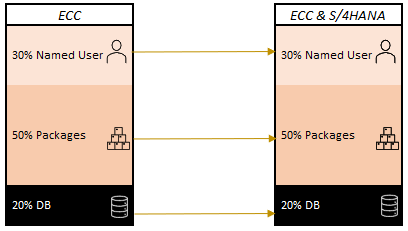S/4HANA – What is it?
S/4HANA SAP’s next generation application ERP – a whole new technical and licensing suite.
It’s the new and improved version from the classic ERP (Enterprise Resource Planning), or commonly known as the Business Suite or also ECC. A key technical difference is that the S/4HANA platform has been optimised for SAP’s own HANA database and therefore, only able to run their own database. With the ECC system you can run a database of your choosing, for example Microsoft, IBM or Oracle. A key licensing difference is that you no longer need Named User licenses for access to Packages, the Package license covers this usage; you need S/4HANA User licenses only for the Digital Core. SAP have created new licenses for Packages and Users, requiring a conversion of your legacy software licenses. Only a few licenses would carry over from ECC to S/4HANA. There is also not a like for like conversion, with some products being consumed as part of the S/4HANA application suite and some being completely rebranded. It is a minefield to try and navigate these differences and ensure not only do you purchase all that you need, but also to avoid ending up with licenses you do not need.
It is critical to note that SAP do not consider this as a legal successor to ECC, but rather a completely new product. This means there are strict restrictions in what you can and cannot do before, during, and after the transition to S/4HANA.
S/4HANA – Why should I move?
Firstly, SAP are only offering mainstream support for Business Suite until the end of 2027. As SAP is critical to the running of your business, it is not advisable to be running your SAP estate unsupported. The larger your SAP estate, the more complex your migration will be and the earlier you want to consider switching. Plus, the earlier you switch the more use you will get out of S/4HANA as this will be under support until at least 2040.
There are other alternatives, such as switching to a 3rd party support supplier or moving off SAP altogether and to a competitor e.g. Oracle. Both are also significant undertakings and may not end up saving you money.
If you choose to stay with SAP, moving to S/4HANA is almost inevitable as SAP ERP will become outdated in this fast-moving technological society. This is the second reason to move to S/4HANA, which also comes with in-memory technology and many simplifications in coding and tables.
This migration offers you an excellent opportunity to cash in your old, unused licenses for credit towards your purchase.
These are some common problems organisations have with their SAP contracts:
• Complex contract history, making it unclear what your rights are and what you own
• Support and maintenance fees on surplus licenses
• Organisational changes, license entitlement no longer reflects your needs
If any of these points sound apply to you, then an S/4HANA migration gives you the opportunity to upgrade your software and restructure your licensing estate. As S/4HANA is a completely new licensing model, your old licenses are eligible to be traded in for credit against your S/4HANA purchase. Of course, terms and conditions apply (see below – How do I begin this process?).
Finally, it may not be the first thing that comes to mind, but an S/4HANA migration also provides a unique opportunity to downscale your overall SAP footprint, if desired. Normally it is difficult to reduce operating costs by terminating SAP shelfware, as you typically are not allowed to partially terminate a license type or order form. Once you’ve migrated to S/4HANA, you are in a new situation with new opportunities.
S/4HANA – When is the best time to move?
The key aspects that determine your organisation’s best timing is, in order of importance, technological needs, organisational circumstances and contractual situation. Each situation can have specific opportunities and leverage.
Common triggers for customers to begin their S/4HANA migration include:
- Updated SAP Roadmap
- Organisational Change e.g. Mergers, Acquisitions or Divestitures
- Require a clean-up or contract consolidation
- Contract harmonisation
As well as waiting for the right time, the other key point is also ensuring that you do not ‘jump the gun’. Purchasing or trading your licenses before any firm ideas about your SAP Roadmap are defined can easily lead to purchasing licenses you may need pre-migration, but do not need post-migration. This can have organisations winding up with as inefficient a licensing estate post-migration as they did before. Not only this, migrating and purchasing licenses well ahead of your technological changes can leave you with a hefty yearly maintenance bill with licenses
that you cannot use until after your migration. Balancing your OPEX and CAPEX with your roadmap and timing is essential to ensure that your migration TCO stays within budget.
There’s no one golden time to move to S/4HANA. Carefully consider whether your organisation has any leverage now or in the future, and when S/4HANA best fits into your company’s roadmap.

S/4HANA – How do I begin this process?
It’s of great importance to understand the process of your S/4HANA migration to appropriately time it. It is a process that can take years to be fully complete, so understanding the steps you need to take will enable you to plan effectively. The diagram below shows JNC’s process that we have executed for a number of our customers going through an S/4HANA migration.

The left-hand side first looks at what it is you currently own and how many licenses you are consuming. We compare this against your roadmap and identify where you require S/4HANA licenses based on what your current licensing position is and considering the future plans you have for SAP. We then have the information to provide you with a list of products that you would require for your migration. The route here splits off into two for your license migration options.
SAP currently offer two methods of migrating your licensing to S/4HANA: Contract Conversion and Product Conversion.
The premise of this option is that you can turn your entire SAP contract history into credit. This credit can then be used to purchase your S/4HANA licenses and you negotiate a new contract with SAP.
The Benefits?
- Enables removal of old shelfware
- Customer entitled to lesser of 100% credit for previous spend or 90% of net NEW payable
- No restrictions on which products can be purchased, flexibility on post-migration state
The Drawbacks?
- Significant planning
- Possibly more expensive
- Contract renegotiation, as previously agreed terms do not carry through
The diagram below shows a simplified view of what happens during a contract conversion. Your old contract moves into credit, and you buy new S/4HANA licenses. The final price you pay for S/4HANA is either 100% credit of your previous spend OR 90% of your net new payable, whichever is lower. For example, your current contract is worth £1.2mill. Your new S/4HANA contract costs £1mill.
100% credit of your £1.2mill = £1.2mill so therefore your final cost is -£200k.
90% of net new payable of £1mill = £900k so therefore your final cost is £100k.
You are entitled to the lesser, which in this case is 90% of net new payable, so you will be paying £100k for your contract conversion.

For this option, you are able to move over piece-by-piece your contract from ECC to S/4HANA. Each product you own will be mapped to the S/4 equivalent.
The Benefits?
- Flexibility on your licenses during the migration
- Entitled to 100% credit
- Keep your existing agreements and terms
The Drawbacks?
- Only trade in licenses that you own, less flexibility on your post-migration state
- Harder to remove shelfware from your estate
- Maintenance Base carries forward at 100%, it may never be reduced
The diagram below shows a simplified view of what happens during a product conversion. You migrate one or more solutions rather than the whole estate. Each product you move to S/4HANA, you must have purchased already. For each conversion you are entitled to 100% credit, though the new licenses may be more expensive than your old ones (depending also on historic vs new discount, metric and volume). If there is no S/4HANA equivalent, then you cannot remove the license at this stage (other than via SAP’s standard extension policies). If you need a license that you don’t already own, you must purchase it without availing of any conversion credit.

Regardless of which option you are going forward with, you can leverage existing “Classic” applications until 2025. This means you can continue to use your ECC applications in conjunction with your S/4HANA applications. The 2 key rules:
1. You must be compliant with license levels across both applications based on the S/4HANA metric level
2. Use of Third-Party DB such as Oracle, MS, DB2: must continue (this is not terminated, it is invoiced) until usage stops
Once this choice has been made, we move onto the right-hand side of the diagram. With all the tools needed to understand what you own, what you require, and your contractual changes, we can start looking at the commercial and negotiation strategy. Utilising our expertise means you can benchmark your pricing and achieve the outcome that’s best for your organisation.
S/4HANA – Anything else I should be considering?
We often see customers using 3rd parties to assist them with their technical S/4HANA migration. Whilst this is an effective strategy, we would warn caution about the licensing aspect. We have seen examples where implementation partners have been given the responsibility of managing the licenses and determining what is required, despite not being licensing experts. Typically, this leads to a licensing estate with some of the following: a suboptimal number of licenses, a lower than achievable discount level (benchmarking), missed opportunities for optimising the type of licence, a lack of flexibility post-migration, a suboptimal approach in phasing the transition (mix of product and contract conversions); all culminating into a (much) higher than necessary maintenance base (running costs).
Proactive is always better than reactive. License migration always comes before technical migration. Engaging expert support before or during your migration can prevent problems from happening, rather than fixing problems that have already happened.
One last consideration is that not all functionality that exists in ECC, will be available on S/4HANA or in the SAP Cloud. SAP limits itself to strategic solutions. If you have a continued need for some legacy functionality, you will likely end up with a hybrid landscape, perhaps a mix of ECC, S/4HANA and SAP Cloud. And don’t forget that you can also achieve a move to the cloud by bringing your SAP on-premise licenses to a third-party cloud host.
JNC can assist you every step of the way from thinking about S/4HANA to implementing. We offer a free 30-minute consultancy session to help you with any questions SAP related. Get in touch to speak with one of our expert consultants.




